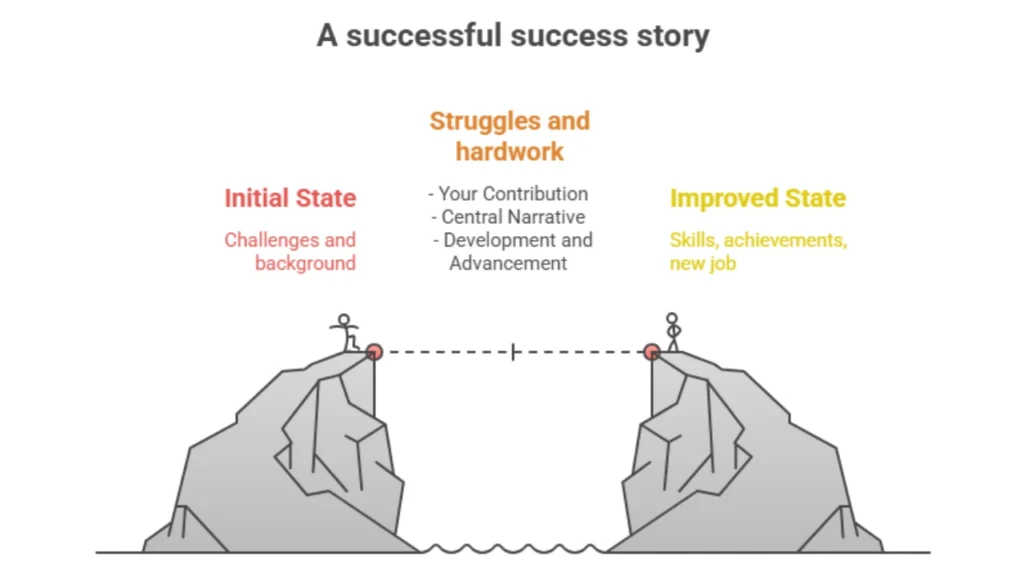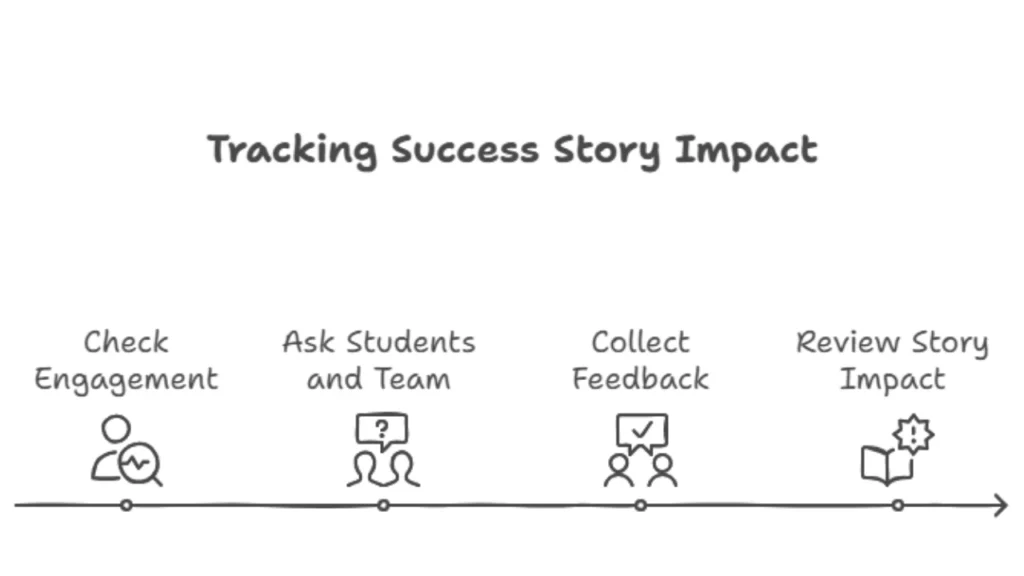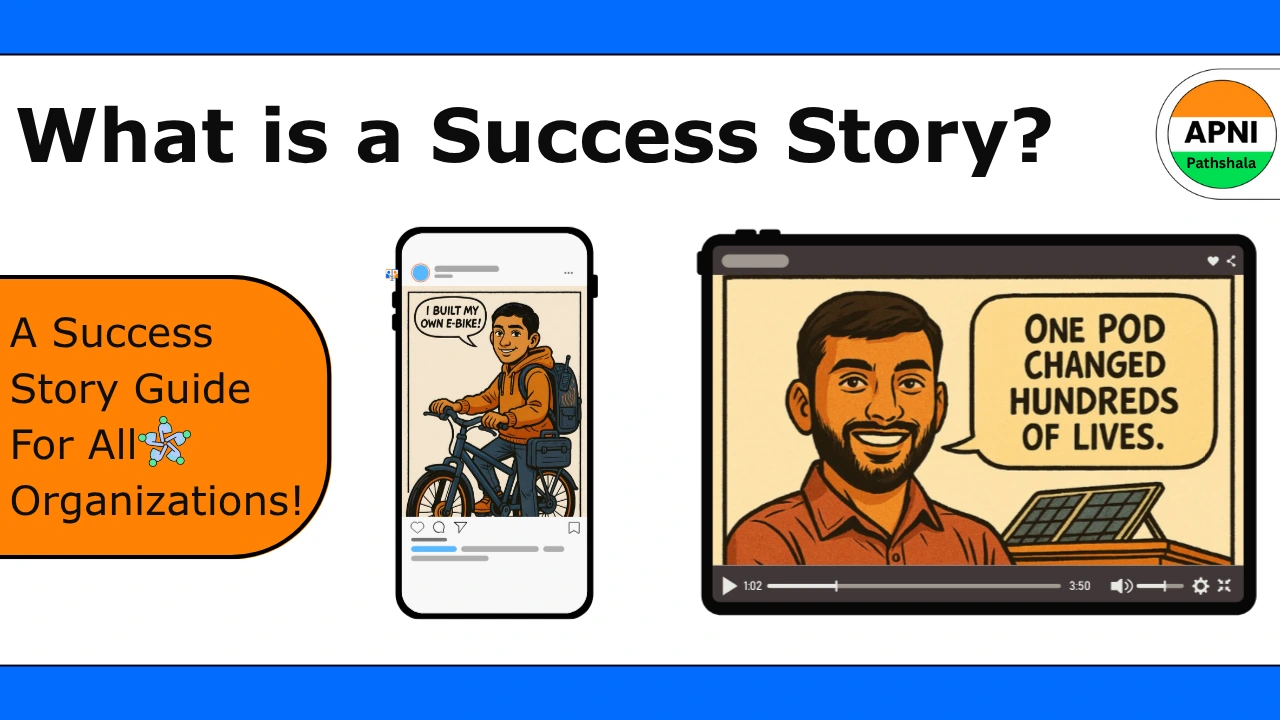A Success Story Guide for all organizations.
What’s the most powerful tool for change?
A story!
Stories demonstrate transformation in people, not just in numbers. They bring your mission to life. For organizations like schools, NGOs, and social enterprises, stories are among the most effective tools to build credibility, earn trust, and inspire others.
Introduction
Imagine a donor deciding where to invest, or a parent wondering whether your program is worth it. Which do you think they will trust more:
Your statistics or your stories?
Success happens daily in purpose-driven organizations, but without documentation, those moments vanish. A success story helps you preserve these milestones and explain your impact in a way that data alone cannot.
This blog will guide you through:
- What a success story truly is (and what it’s not)
- Why does it matter to your organization’s growth?
- How to document it properly
- How to turn it into content for various audiences
- Where to publish it for maximum reach
- How to track the story’s impact
What Is a Success Story?
A success story illustrates how someone’s life was transformed through their hard work in overcoming challenges. It emphasizes their personal growth, changes in mindset, and improvement in skills, highlighting how your involvement ensured they reached their goals.
What It’s Not
- A list of ranks or certificates
- General praise from a beneficiary
- A count of how many people attended a session
Example: Saying “We taught 500 girls coding” is good data. But saying “How a 14-Year-Old Built an E-Bike from Scratch Without Formal Training?” is a success story.
Why Success Stories Matter
For mission-driven organizations, success stories can:
- Motivate staff and volunteers
- Build trust with donors, partners, and investors
- Increase visibility on social media and websites
- Make your work relatable to communities
- Act as long-term assets that reflect your purpose
Quote: “Stories create community, enable us to see through the eyes of other people, and open us to the claims of others.” – Peter Forbes
What Makes a Good Success Story?
Strong success stories usually contain these five elements:
- A visible transformation (mindset, skills, confidence)
- A clear challenge or struggle
- A support system, how your program helped
- Honest emotion
- An inspirational or relatable ending
If a story checks at least three of these, it’s worth capturing.

How to Document a Success Story
Format to Follow
- Who: Name, age, background, location
- Before: What challenges did they face?
- Your Role: How your team, program, or resources helped
- After: What changed? New skills, jobs, achievements
- Today: What is the person doing now?
- Quotes: Let them speak in their own words
- Media: Photos, short videos, or voice notes
Keep each story consistent. Always mention location, date, and program type.
How to Turn Stories into Powerful Content
Different people absorb stories in different ways. Choose formats that match their attention span and content habits.
| Format | Purpose | Best For |
| Short Videos (30–60 sec) | Quick, high-emotion visual story | Instagram, YouTube Shorts, WhatsApp |
| Posts | Tell a story through Posts and Images | Instagram, Facbook, YouTube community posts, X (Twitter), LinkedIn, |
| Comic or Illustration | Simple, relatable visual story | Low-literacy communities, student groups |
| Blog | Deeper insights with emotion and context | Websites, partner newsletters |
| Mini Documentary (2–4 mins) | Rich visual storytelling | Fundraising decks, YouTube, donor events |
Use reels to quickly grab attention, blogs to provide depth, and comics to engage younger or rural audiences.
Where to Publish Based on Your Audience
| Target Audience | Platforms to Use |
| Students / Youth | WhatsApp, Instagram Reels, YouTube Shorts |
| Organization / Teams | Blogs, LinkedIn posts, and field newsletters |
| Donors / CSR / Investors | Annual reports, testimonials, mini-documentaries |
| Community Leaders | Community events, posters, WhatsApp groups |
| General Public | Website blog section, Instagram feed, story highlights |
Each platform needs a custom tone and length.
How to Track Success Story Impact
Tracking will help you understand what works and how to improve future storytelling.
- 📊 Check engagement (likes, comments, shares, link clicks)
- 📝 Ask students and team members if they read or shared it
- 📬 Collect feedback from donors, partners, or volunteers
- 🎯 Review how many stories led to increased interest or support

Use these results to plan your next success story round.
Conclusion
In this blog, we explored what a success story truly means and why it matters to schools, NGOs, and mission-driven organizations. We defined the difference between data and storytelling, shared clear criteria for identifying strong stories, and provided practical steps to document, format, publish, and track them effectively.
Success stories are not just testimonials or statistics; they are proof of transformation. They build trust with funders, engage communities, and inspire internal teams. For any organization that wants to grow its impact and credibility, storytelling isn’t optional; it’s essential.
Here’s a simple path you can follow:
- Find a story that reflects real change and emotion
- Document it with a consistent format and meaningful detail
- Share it using formats that suit your audience and platform
- Track engagement, response, and feedback
- Repeat what resonates to strengthen your communication
A good story doesn’t just describe impact—it delivers it.
If you’re wondering how to begin, start by reading examples from others.
👉 Check out real success stories on ApniPathshala BLOGs and COMICs to learn how powerful stories are told.Now a question for you:
Which success story inspires you the most? Write your thoughts in the comments.


1 Comment
I really feel these success stories should reach those students who are capable of becoming next success stories of ApniPathshala, so let’s share this with everyone.